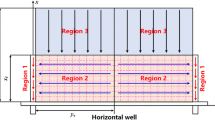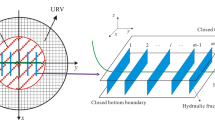Aiming at the problem that the water intrusion control factors of multi-stage fracturing horizontal wells in tight gas reservoirs in edge and bottom water are not clear, the linear supply boundary is used to characterize the water intrusion characteristics and derive the mathematical characterization formula, considering the stress sensitivity and diffusion mechanisms of tight gas, and the water intrusion flow model of multi-stage fracturing horizontal well in tight gas reservoirs in edge and bottom water is established, and the bottom pressure and its derivative curves are obtained by Laplace and perturbation transformation. Furthermore, the influence of water intrusion strength, matrix-fracture channeling capacity, storage capacity coefficient, fracture segment spacing, fracture conductivity and other factors on the degree of water intrusion and water exposure time were analyzed. By fitting the well test data of the established model, the water intrusion intensity parameters can be obtained, and the water intrusion control of gas wells can be guided according to this parameter. The data analysis of two typical wells in the western oilfield was carried out by applying the established model, and the analysis results were well matched with the actual production, which verified the reliability of the model, and according to the analysis results, the treatment measures of the two wells were proposed, and the two wells obtained good production results.







Similar content being viewed by others
References
Jiang R., Xu J, Sun Z., et al. Rate transient analysis for multistage fractured horizontal well in tight oil reservoirs considering stimulated reservoir volume. Mathematical Problems in Engineering, 2014.
Wei M., Duan Y., Dong M., et al. Blasingame decline type curves with material balance pseudo-time modified for multi-fractured horizontal wells in shale gas reservoirs, Journal of Natural Gas Science & Engineering, 2016, 31: 340-350.
Cao L. N., Li X. P., Luo C., et al. Horizontal well transient rate decline analysis in low permeability gas reservoirs employing an orthogonal transformation method, Journal of Natural Gas Science and Engineering, 2016, 33: 703-716.
Ozkan E., Brown M., Raghavan R., et al. Comparison of Fractured-Horizontal-Well Performance in Tight Sand and Shale Reservoirs, Spe Reservoir Evaluation & Engineering, 2011, 14, 2: 248-259.
Stalgorova E., Mattar L.. Analytical Model for Unconventional Multifractured Composite Systems, Spe Reservoir Evaluation & Engineering, 2013, 16, 3: 246-256.
Liu Zhen-yu, Lu Xiu-feng, Li Li. The treatment method of the third type of boundary conditions in the finite element method numerical well test analysis, Chinese Journal of Hydrodynamics Series A, 2009, 03: 273-278.
Sun Hedong. A balance equation of gas materials with recharge capacity and their performance prediction, Act A Petrolei Sinica, 2011. 32, 04: 683-686.
Xu Zhenping, Liao Hongmei, Li Xiaofeng, et al. New model of gas wells under consideration of dynamic supplying in tight sandstone gass reservoirs with great heterogeneity, Fault-Block Oil &Gas Field, 2018, 25, 002: 236-239.
Yu W., Wu K., Sepehrnoori K., et al. A Comprehensive Model for Simulation of Gas Transport in Shale Formation with Complex Hydraulic Fracture Geometry, SPE Reservoir Evaluation & Engineering, 2015.
Jia P., Cheng L., Huang S., et al. A Semi-Analytical Model for Production Simulation of Complex Fracture Network in Unconventional Reservoirs, the SPE/IATMI Asia Pacific Oil & Gas Conference and Exhibition, Nusa Dua, Bali, Indonesia, 2015.
Fang Sidong, Cheng Linsong, Li Caiyun, et al. Production model of horizontal wells fractured by multi-angle fractures in stress-sensitive reservoirs, Journal Of Northeast Petroleum University, 2015, 39, 01: 87-94+6.
Yang R., Huang Z., Yu W., et al. A Comprehensive Model for Real Gas Transport in Shale Formations with Complex Non-planar Fracture Networks, Scientific Reports, 2016, 6, 1: 36673.
Li Xucheng, Jiang Chao, Wu Yue, et al. Analysis of influencing factors of steady-state productivity of fracturing horizontal wells in tight gas reservoirs, Natural Gas Technology and Economy, 2016, 10, 03: 39-42+45+82+83.
Ren Zongxiao, Wu Xiaodong, Jin Gang, et al. Semi-analytical seepage model of volumetric fracturing horizontal wells in tight reservoirs, Oil Drilling & Production Technology,38, 2016, 05: 633-369.
Gringarten A. C., Ramey H. J. The Use of Source and Green’s Functions in Solving Unsteady-Flow Problems in Reservoirs, Society of Petroleum Engineers Journal, 1973, 13, 05: 285-296.
Xie Yaxiong, Liu Qiguo, Wang Weihong, et al. Productivity prediction model of multi-stage fracturing horizontal wells in shale gas reservoirs, Petroleum Geology & Oilfield Development in Daqing, 2016, 35, 05: 163-169.
Liu Qiguo, Cen Xuefang, Li Longxin, et al. Study on the applicability of trilinear flow model for multi-stage fracturing horizontal wells, Petroleum Reservoir Evaluation and Development, 2018, 8, 02: 63-67+72.
Izadi M., Yildiz T. Transient Flow in Discretely Fractured Porous Media, SPE Journal, 2009, 14, 02: 362-373.
Author information
Authors and Affiliations
Corresponding author
Additional information
Translated from Khimiya i Tekhnologiya Topliv i Masel, No. 2, pp. 73–78, March– April, 2024.
Rights and permissions
Springer Nature or its licensor (e.g. a society or other partner) holds exclusive rights to this article under a publishing agreement with the author(s) or other rightsholder(s); author self-archiving of the accepted manuscript version of this article is solely governed by the terms of such publishing agreement and applicable law.
About this article
Cite this article
Chen, D., Yang, F., Li, H. et al. Study on Water Intrusion Flow Model of the Tight Gas Reservoir. Chem Technol Fuels Oils 60, 297–308 (2024). https://doi.org/10.1007/s10553-024-01684-z
Published:
Issue Date:
DOI: https://doi.org/10.1007/s10553-024-01684-z




